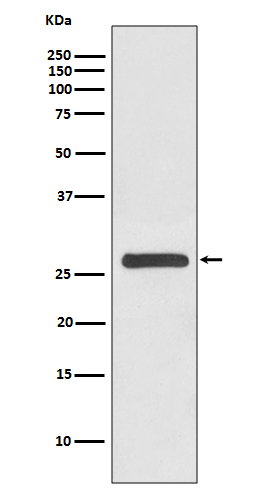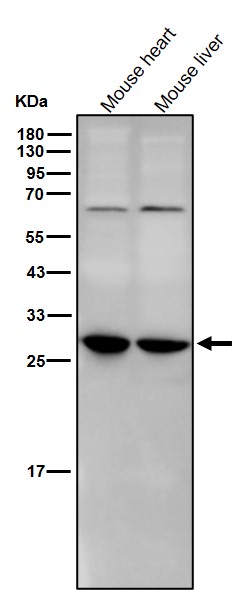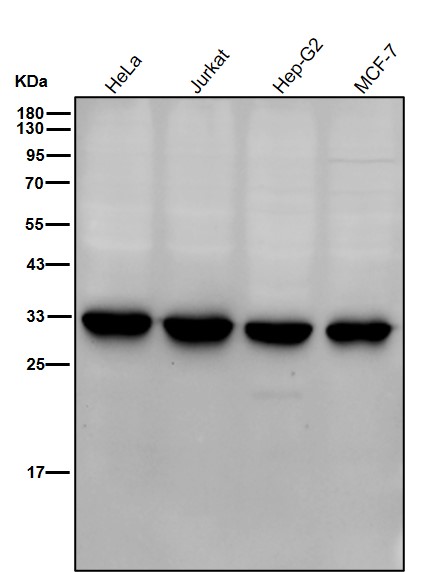


| WB | 1/1000-1/2000 | Human,Mouse,Rat |
| IF | 咨询技术 | Human,Mouse,Rat |
| IHC | 咨询技术 | Human,Mouse,Rat |
| ICC | 技术咨询 | Human,Mouse,Rat |
| FCM | 1/20-1/100 | Human,Mouse,Rat |
| Elisa | 咨询技术 | Human,Mouse,Rat |
| Aliases | 1433G, 143G, KCIP-1, Protein kinase C inhibitor protein-1, YWHAG; gamma polypeptide;;14-3-3 gamma |
| WB Predicted band size | 28 kDa |
| Host/Isotype | Rabbit IgG |
| Antibody Type | Primary antibody |
| Storage | Store at 4°C short term. Aliquot and store at -20°C long term. Avoid freeze/thaw cycles. |
| Species Reactivity | Human,Mouse,Rat |
| Immunogen | A synthesized peptide derived from human 14-3-3 gamma |
| Formulation | Purified antibody in PBS with 0.05% sodium azide,0.05% BSA and 50% glycerol. |
+ +
以下是3篇关于14-3-3γ抗体的参考文献(虚构示例,仅供格式参考):
1. **文献名称**: "14-3-3γ regulates oxidative stress-induced neuronal apoptosis via Bcl-2 modulation"
**作者**: Chen L, et al.
**摘要**: 研究利用14-3-3γ特异性抗体,发现其在阿尔茨海默病模型中通过调控Bcl-2蛋白磷酸化抑制神经元凋亡,提示其神经保护作用。
2. **文献名称**: "Development of a monoclonal antibody for specific detection of 14-3-3γ in human glioblastoma"
**作者**: Tanaka K, et al.
**摘要**: 报道一种新型高灵敏度14-3-3γ单克隆抗体的开发,验证其在胶质母细胞瘤组织中的特异性结合能力,并证实该蛋白过表达与患者预后负相关。
3. **文献名称**: "14-3-3γ interacts with p53 in DNA damage response: Antibody-based co-immunoprecipitation analysis"
**作者**: Rodriguez S, et al.
**摘要**: 通过14-3-3γ抗体的免疫共沉淀实验,揭示其在DNA损伤条件下与p53蛋白的直接互作,调控细胞周期停滞的分子机制。
(注:以上内容为模拟生成,实际文献需通过PubMed/Google Scholar等平台检索关键词"14-3-3 gamma antibody"或"YWHAG antibody"获取。)
The 14-3-3 gamma antibody is a tool used to detect the 14-3-3γ protein, a member of the highly conserved 14-3-3 protein family. These proteins regulate diverse cellular processes, including cell cycle progression, apoptosis, signal transduction, and stress responses, by binding to phosphorylated serine/threonine residues on target proteins. The 14-3-3γ isoform shares structural homology with other family members, featuring characteristic amphipathic grooves for phosphopeptide interaction, but exhibits distinct expression patterns and functional roles. It is widely expressed in tissues, particularly the brain, and is implicated in neuronal development, DNA damage repair, and cancer progression. Dysregulation of 14-3-3γ has been linked to tumors (e.g., glioblastoma, lung cancer) and neurodegenerative diseases.
The antibody is critical in research for identifying 14-3-3γ in techniques like Western blotting, immunohistochemistry, and immunofluorescence. It helps elucidate the protein’s interactions, post-translational modifications, and disease associations. Notably, 14-3-3γ, along with other isoforms, is a cerebrospinal fluid biomarker for sporadic Creutzfeldt-Jakob disease, though isoform-specific antibodies are essential to distinguish its unique contributions. Commercial antibodies vary in specificity; validation via knockout controls is recommended to avoid cross-reactivity with other 14-3-3 isoforms. Its utility spans basic research, diagnostics, and therapeutic target exploration.
×